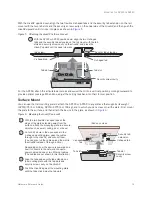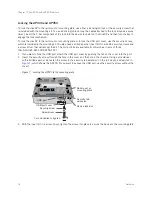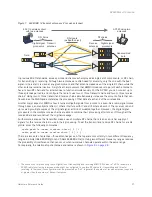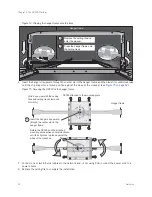
Chapter 2 The AP340 Platform
26
Aerohive
Figure 5 Directional antenna patterns
Omnidirectional Antennas
You typically orient omnidirectional antennas vertically, positioning them on all devices in the same direction.
Omnidirectional antennas create coverage areas that can be toroidal (doughnut-shaped) or cardioid (heart- or
plum-shaped), broadcasting to the sides much more effectively than up or down (see
). In general, this
is good for most office environments because you have large flat floors. However, it can be a problem in
environments with high ceilings.
Figure 6 Omnidirectional antenna radiation patterns
MIMO
MIMO (Multiple In, Multiple Out) is a major WLAN advancement introduced in the IEEE 802.11n standard in
which multiple RF links are formed on the same channel between the transmitter and receiver simultaneously.
To accomplish this, the transmitter separates a single data stream into multiple spatial streams, one for each RF
chain (an a various digital signal processing modules linked to the antenna). The transmit antennas at
the end of each RF chain then transmit their spatial streams. The recipient’s receive antennas obtain streams
from all the transmit antennas. In fact, due to multipath, they receive multiple streams from each transmit
antenna. The receive antennas pass the spatial streams to the digital signal processors in their RF chains,
which take the best data from all the spatial streams and reassemble them into a single data stream once again
(see
).
Higher gain
Lower gain
(Bird’s eye view)
Patch
antennas
Higher gain
Toroidal pattern Cardioid pattern
Содержание Aerohive APs
Страница 1: ...Aerohive Hardware Reference Guide ...
Страница 7: ...Contents 6 Aerohive ...
Страница 17: ...Chapter 1 The AP330 and AP350 Platforms 16 Aerohive ...
Страница 47: ...Chapter 3 The AP320 Platform 46 Aerohive ...
Страница 61: ...Chapter 4 The AP170 Platform 60 Aerohive ...
Страница 91: ...Chapter 8 The High Capacity HiveManager 90 Aerohive ...






























